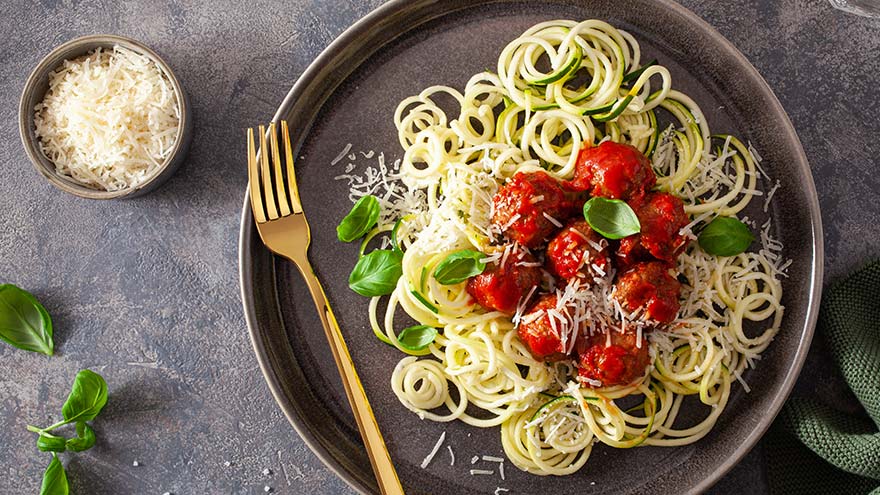Use This, Not That: 8 Healthy Cooking Swaps
December 21, 2017

If you’re looking for an easy way to add a nutritious kick to your favorite brownie, pizza or cream sauce recipe, check out these healthy ingredient substitutions.
There’s no doubt about it: People love decadent, creamy and starchy dishes. If you’re prone to avoiding your favorite guilty pleasure because it’s not a healthy choice, there are a few easy, healthy and delicious substitutions you can add to your cooking or baking routine to satisfy your cravings. Here are eight of our favorite healthy substitutions you might have in your kitchen right now:
Baking Swaps
Avocados for Butter
While this might not sound like an appetizing addition, avocado's creamy texture is similar to butter and can easily be added to brownie and cookie recipes. Avocados are high in healthy fats that help to lower cholesterol and are lower in saturated fats. They also can add vitamin E, fiber and potassium to your baked goods.Swap Amount: Substitute 1 cup blended avocado per 1 cup butter.
Bananas for Oil
Bananas are a tasty option to replace the use of oil in baking recipes. While oil is higher in fat and calories, bananas can provide potassium, fiber, vitamin B6 and all-natural sweetness to your recipe. Do take into account that bananas are higher in sugar and carbohydrates.Swap Amount: Substitute 1 cup of mashed bananas per 1 cup of oil.
Beans for Flour
You might not typically think of beans as a substitution, but they can add a lot of nutritional benefits to your treats. High in protein, fiber, folate, magnesium and phosphorous, beans are a great substitution for traditional flour in recipes and create a moist and dense texture to your baked goods.Swap Amount: Substitute 1 cup of blended beans (about a 15 ounce can) per 1 cup of traditional flour.
Or, Wheat Flour for White Flour
If the bean substitution doesn’t appeal to you, try substituting at least half or all of your unbleached white flour for whole wheat flour. Keep in mind for every cup of whole wheat flour you use, add another 1/4 cup of water to your recipe. This will add more fiber, protein, B vitamins, and several minerals for your baking recipe and scrumptious treats.Chia Seeds or Flax Seeds for Eggs
This is a great substitution if you're allergic to eggs or have a vegan diet, but still want to enjoy desserts and breads. Chia and flax seeds are high in omega-3 fatty acids and calcium along with fiber, vitamins and minerals to help promote healthy digestion. This substitution will not provide as much protein as an egg would; however, there is less cholesterol and saturated fat.Swap Amount: Combine 1 tablespoon of ground chia or flax seeds mixed with 3 tablespoons of water, stir and let sit for 15 minutes. Equals one whole egg equivalent.
Cooking Swaps
Nonfat Greek Yogurt for Mayonnaise
Making this switch is an easy replacement for sauces and dressings. Nonfat Greek yogurt is significantly lower in fat and calories and higher in protein. With the added protein, you will feel fuller longer throughout the day. Swap Amount: Substitute equal parts nonfat Greek yogurt for mayonnaise. Try mixing it into a cheese sauce or add lemon juice and spices for a creamy salad dressing.Lemon Juice or Vinegar for Salt
If you are worried that your food will be bland, try this swap to lower added salt and still enjoy flavor while creating a fresh, tangy twist to the meal. There are a lot of varieties -- red wine, apple cider and balsamic -- each enhancing your dish with a different flavor.Swap Amount: Experiment by using half the amount of vinegar or lemon juice per the amount of salt your recipe calls for.
Cauliflower for Pizza Crust
Try a new twist on pizza by switching out its carbohydrate dense crust with fresh cauliflower. This substitution is lower in calories, fat, and simple carbohydrates while increasing your vitamin C and vegetable intake for the day.Swap Amount: Add one egg per every head of cauliflower and season with spices to taste, for a medium sized pizza.
Or, Mashed Potatoes
Preparing a homemade cauliflower pizza crust can be time consuming, so an easier exchange might be to substitute mashed cauliflower for mashed potatoes, which are higher in starches, calories and carbohydrates.
Swap Amount: Boil and puree a medium size head of cauliflower. Add a splash of low fat milk and season to taste.
Zucchini or Squash for Spaghetti
Another great way to add vegetables to your meals is to exchange ribbons of zucchini or spaghetti squash for spaghetti noodles. This substitution helps to reduce calories and carbohydrates and zucchini is rich in vitamin A. Experiment with different sauces and spices to create a variety of dishes.
Swap Amount: For zucchini ribbons, try using a mandolin or a peeler. When preparing spaghetti squash, cut it in half and lay face down in an oven safe pan. Add 1/2 inch of water to the bottom of the pan for more tender spaghetti strings (optional). Cook for 30 to 45 minutes until tender. Lie the squash face up, letting it slightly cool, and then use a fork to gently pull the squash from the peel, separating into strands.
Remember: Some of these substitutions will affect the taste and texture of your recipes, so it is essential to play with the ratios to find the perfect fit for you. Consume a variety of foods, eat treats in moderation, and incorporate frequent physical activity to keep a well balanced, healthy lifestyle.